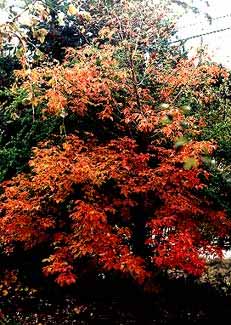 The Paperbark Maple
The Paperbark Maple
by the Front Walk
"I rested on the breezy height,
In cooler shade & clearer air,
Beneath a maple tree;
Below, the mighty river took
Its sparkling shade & sheeny light
Down to the sombre sea."
-Duncan Campbell Scott
(1862-1947)
(1862-1947)
The photo at left of our Paperbark Maple (Acer griseum) was taken in November 2002, & the fourth photo below in November 2005, showing its autumn colors. Other striking November portraits can be seen in the Autumn Trees Gallery's Paperbark Maple Page. Not much visible in these photos are lots of shade-plants lost in the shadows under & around the maple in quite an elaborate garden.
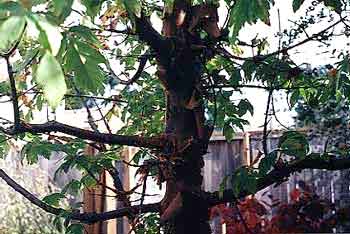
The birds love this tree because of its proximity to a feeder & a birdbath. One day I was on hands & knees working underneath this tree when chickadees started hanging from the peeling bark a scant arm's length from my face. I can also sit on the front porch & watch several kinds of birds hopping about in its branches. The birds will come right up on the porch & hop around my feet if I sit still enough.
The second photo, at right, is a so-so picture closer in, taken about September (2001), showing the peeling bark of the trunk.
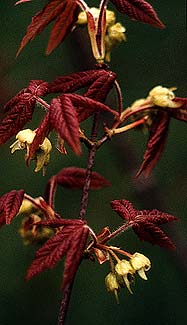
The Paperbark looks lovely year-round because even after all the leaves drop off, it still has that amazing curling cinnamon-colored bark, pictured to best advantage on the Paperbark Maple Page along the Winter Bark Garden Walk.
The cinnamon-red pealing bark is very reminiscent of the madronna trees that grow all over the Northwest, but those madronnas can be rather brittle trees to grow too close to one's house on a windy hilltop like ours.
I'd wanted a paperbark from the first time I saw an old one, but the specimens I saw for sale were so small, & the literature says they grow slowly. I didn't feel like a sapling was going to measure up to a decent sized tree.
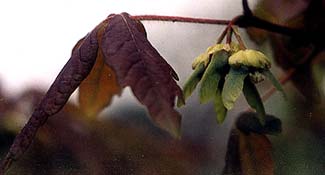
We finally found a tall one surprisingly affordable, & had that delivered. It was already above the eaves of our house & immediately looked like it had been there for years! So it was a good thing we didn't get impatient & go for a sapling back when that's all we could find for sale.
It also offset perfectly the green weeping beech that had looked a little lonely in the yard. The beech was so bizarrely twisted & extreme, it really needed to have something "normal" nearby to keep it from being so overt; the maple did the trick. And as the Paperbark is turning bright orange & read in Autumn, the beech is turning coppery golden-leafed.
Eventually I will install a flagstone path between the paperbark & the weeping beech through an area that is presently turfed.
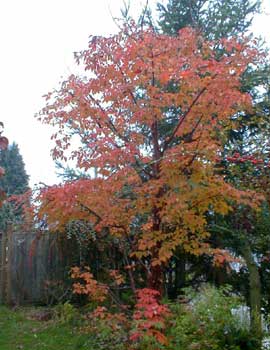
The east half of this yard is now "boxed in" with trees. Not counting the evergreens below the cliff. The main trees in this area are a Young's tortured weeping birch (Betula youngii pendula), the weeping green beech (Fagus sylvatica 'Pendula'), the paperbark maple, & a small Witchhazel which could conceivably be pretty big itself someday but is presently only a bush. If you look through the branches of the close-up of the paperbark branches, you will see in the lower left-hand corner a few sprays of the Young's weeping birch showing — the smallest birds love that one a lot, it must feel good on their little bird-feet.
On the cliff itself is a large fountaining Franchet's cotoneaster overhanging the afore mentioned birdbath, & in among the shady areas are such things as dwarf rhodies, numbers of ferns, trilliums, jack-in-the-pulpits, hardy fuchsias that bloom right up to winter, hepaticas, cyclamens, & lots else.
It's definitely bird heaven amidst all this, but it's also cat heaven. At last count three different cats were taking turns visiting to lurk in the greenery watching birds. One morning we found the "gift" of a full grown robin left for us, dead, right at the door, friendly little sweet evil murdering kitty, I'm sure glad I'm not small as a bird.
In early May the Paperbark begins to burst into purple leaf. The emerging-purple leaves slowly fade to a bright sunny green when fully developed by May's end. The earlier May flower photo, & the mid-May photo of the seeds that displace the flowers, show also the color of the emerging leaves before they reach their full sized & turn green. The seeds hang on to the tree until autumn or longer.
New green leafage occurs well after the Young's birch has bloomed then leafed, & about the same time as, but a little ahead of, the weeping green beech. Also through May it blooms very prettily, followed swiftly by the appearance of seeds. In spring it is changing so quickly day by day, no single photo can capture its antics.
The blooms & seeds progress so rapidly that through a two or three week period, the branches looked different almost every single day. When the blooms first appear there is hardly more than leaf-buds on the tree, but by the time the young mothwing seeds are substantial, the leaves are lush.